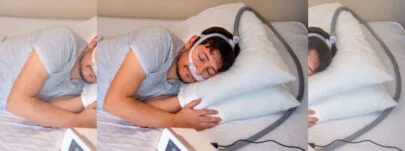
Best Practices for Using an Oxygen Connector for CPAP
A positive airway pressure, or PAP, device is the most commonly used and best method to control obstructive sleep apnea. This sleep condition affects countless millions of people around the world and, if left untreated, can lead to many serious medical issues with the heart and lungs.
People with obstructive sleep apnea (OSA) suffer from disrupted sleep as they are constantly briefly awoken by pauses in breathing and the body reacts to the lack of oxygen.
A PAP device comprises multiple parts including the compressor, tubing and a mask and each has an important role to play if the treatment is to be effective.
Obviously, all components must be maintained to a high standard and cleaned regularly — but there is one important factor that is often overlooked.
It should be obvious, but many users often fail to recognize the importance of the oxygen connector for PAP devices when oxygen therapy is required.
PAP and Oxygen Therapy
For many OSA sufferers, ordinary PAP therapy is adequate, but this is not always the case. A sleep specialist or doctor may also advise supplemental oxygen therapy to improve the effectiveness of the OSA treatment. This form of treatment is often used in conjunction with PAP therapy and the PAP device being used can often be adapted to fit this need.
While both PAP and oxygen therapies are used to treat obstructive sleep apnea (and other sleep or breathing conditions) there are some differences in their function and purpose:
PAP Therapy
This form of treatment uses a continuous positive airway pressure device to deliver a steady flow of pressurized air to the user’s nose and/or mouth via a system of tubing and mask. This steady airflow prevents soft tissues in the throat from constricting or blocking the airway as they relax during sleep.
Oxygen Therapy
Very similar in functionality to a PAP device but uses an oxygen tank as a supply source rather than the air in the room. Oxygen therapy is primarily used for patients who have low oxygen levels due to certain medical conditions.
The principal difference between the two systems is that oxygen therapy does not deliver oxygen under the pressure required to keep the air passage clear during sleep.
Combined Therapies
Although PAP treatment and oxygen therapy are generally used for different ailments, there are occasions when the two can be combined. In the case of obstructive sleep apnea sufferers, it may be advisable to supplement the CPAP therapy with an additional supply of oxygen.
This may be for medical reasons or due to an existing breathing problem. If this should be deemed necessary or advisable it is often possible to use an existing PAP system and link it to an oxygen system.
Depending on the PAP system being used there are two possible options available:
Bleed-in Connector. This is an adapter with a port from the oxygen system. This is attached at some point in the PAP tubing and the oxygen is then “bled” into the pressurized air being circulated.
Integrated Connector. Some PAP devices already contain a built-in oxygen connector and it is simply a matter of hooking up the oxygen connector for CPAP machines if such a port is available.
It may also be the case that older versions of PAP masks have an oxygen port built in but such masks are few and far between in the modern era as other systems of delivering oxygen are now preferred.
Oxygen therapy is not generally employed for obstructive sleep apnea cases and is only used on the recommendation of the sleep specialist or doctor responsible. This is because too much (or too little) oxygen can be dangerous and even life-threatening.
There are three oxygen systems currently available that may be used in conjunction with a PAP device:
Oxygen concentrator
Oxygen tank
Compressed oxygen tank
Each system has its own benefits and shortcomings and the decision which one is best will depend on the individual’s existing type of PAP device and personal preferences.
Connectivity Issues
In those cases where an obstructive sleep apnea sufferer is also recommended additional oxygen it is usually possible to connect the oxygen supply to the CPAP device. Whether it is an oxygen tank or oxygen concentrator, there will either be some type of adapter or a direct oxygen connector for PAP devices available.
Oxygen concentrators are usually connected from the concentrator’s input valve to the PAP mask but not all older masks have this feature. For older masks it may be necessary to add a bleed adapter or combine the existing system with additional tubing incorporating a bleed line for the oxygen.
This may sound like a complicated process, but it is in fact quite simple to carry out once properly explained. For many obstructive sleep apnea sufferers who are recommended oxygen, the existing PAP device can easily accommodate the new oxygen input. For others, the system may need a little adjustment, but this will be explained by the doctor in charge or the equipment vendor.
Positive Outcome
The use of CPAP and oxygen therapy in unison is not all that common, but more likely to be the case for elderly OSA sufferers and those with other sleeping or respiratory disorders. When the two therapies are recommended, one should not be prioritized over the other — as both are equally important components for the patient’s overall well-being.
Every piece of equipment plays a vital role in the functionality of the device and the effectiveness of treatment. From the fitting of the mask -to the oxygen connector for CPAP equipment — everything should be checked for wear or damage — and everything properly maintained if a positive outcome is to be achieved.



